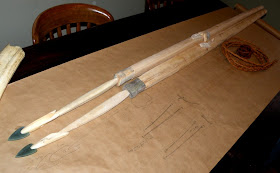 I'm not sure if I can get the Thule harpoons done before the holidays. I still have a bunch of shopping to do for Christmas and the festivities start on Wednesday. I don't have a whole lot to do on the harpoons, but the next few steps involve a bit of drying time and a lot of sanding. The harpoon work is dirty work - the whalebone smells like sour fish when you grind it and the ivory like burning teeth. It gets in your clothes and your hair. I don't mind it, but it means that I like to have a big block of time dedicated to the workshop on the days when I need to be covered in mess like that. Ok, I just decided, here's the plan - I'm going shopping this morning and then I'll have the rest of the afternoon and evening to work on the harpoons.
I'm not sure if I can get the Thule harpoons done before the holidays. I still have a bunch of shopping to do for Christmas and the festivities start on Wednesday. I don't have a whole lot to do on the harpoons, but the next few steps involve a bit of drying time and a lot of sanding. The harpoon work is dirty work - the whalebone smells like sour fish when you grind it and the ivory like burning teeth. It gets in your clothes and your hair. I don't mind it, but it means that I like to have a big block of time dedicated to the workshop on the days when I need to be covered in mess like that. Ok, I just decided, here's the plan - I'm going shopping this morning and then I'll have the rest of the afternoon and evening to work on the harpoons. Most of the bits and pieces are ready to assemble. I've been using The Ruin Islanders by Karen McCullough as a reference on this project, so one of the harpoons has a bit of an Ellesmere Island flavour to it. The little duck shaped tension peg in the photo on the left is based on Ruin Island artifacts, as is the smaller, single barbed harpoon head. The other harpoon will have little more of a Labrador feel to it. Compared to the Palaeoeskimo harpoons, the Thule seem to have had a lot more room for personal style in their toolkit. There is a lot more variability in the Thule harpoon technology than the preceding Palaeoeskimo.
Most of the bits and pieces are ready to assemble. I've been using The Ruin Islanders by Karen McCullough as a reference on this project, so one of the harpoons has a bit of an Ellesmere Island flavour to it. The little duck shaped tension peg in the photo on the left is based on Ruin Island artifacts, as is the smaller, single barbed harpoon head. The other harpoon will have little more of a Labrador feel to it. Compared to the Palaeoeskimo harpoons, the Thule seem to have had a lot more room for personal style in their toolkit. There is a lot more variability in the Thule harpoon technology than the preceding Palaeoeskimo. I still have some holes to drill and an ivory piece to make for the butt end of each harpoon. The foreshafts are laced on to the mainshafts with a single long leather thong that threads through a series of four holes on the mainshaft and two holes through the foreshaft. The holes aren't there yet, but in the photo below, I'm ready to copy the hole locations from my brown paper pattern to the harpoons.
I still have some holes to drill and an ivory piece to make for the butt end of each harpoon. The foreshafts are laced on to the mainshafts with a single long leather thong that threads through a series of four holes on the mainshaft and two holes through the foreshaft. The holes aren't there yet, but in the photo below, I'm ready to copy the hole locations from my brown paper pattern to the harpoons.Photo Credits: Tim Rast
Photo Captions:
Top: Harpoons, almost finished
Second: Whalebone and ivory tension pieces and finger rests. Some of these pieces will fit into the mainshaft and be secured with baleen lashings, while others will be tied to the harpoon line using sinew
Third: Harpoon heads, done, except for some polishing and missing lines
Fourth: Laying out the harpoons to mark the foreshaft/mainshaft lacing holes.


No comments:
Post a Comment